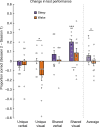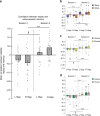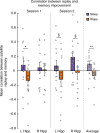Human hippocampal replay during rest prioritizes weakly learned information and predicts memory performance
- PMID: 30254219
- PMCID: PMC6156217
- DOI: 10.1038/s41467-018-06213-1
Human hippocampal replay during rest prioritizes weakly learned information and predicts memory performance
Abstract
The hippocampus replays experiences during quiet rest periods, and this replay benefits subsequent memory. A critical open question is how memories are prioritized for this replay. We used functional magnetic resonance imaging (fMRI) pattern analysis to track item-level replay in the hippocampus during an awake rest period after participants studied 15 objects and completed a memory test. Objects that were remembered less well were replayed more during the subsequent rest period, suggesting a prioritization process in which weaker memories-memories most vulnerable to forgetting-are selected for replay. In a second session 12 hours later, more replay of an object during a rest period predicted better subsequent memory for that object. Replay predicted memory improvement across sessions only for participants who slept during that interval. Our results provide evidence that replay in the human hippocampus prioritizes weakly learned information, predicts subsequent memory performance, and relates to memory improvement across a delay with sleep.
Conflict of interest statement
The authors declare no competing interests.
Figures





Similar articles
-
Reverse replay of behavioural sequences in hippocampal place cells during the awake state.Nature. 2006 Mar 30;440(7084):680-3. doi: 10.1038/nature04587. Epub 2006 Feb 12. Nature. 2006. PMID: 16474382
-
Awake replay of remote experiences in the hippocampus.Nat Neurosci. 2009 Jul;12(7):913-8. doi: 10.1038/nn.2344. Epub 2009 Jun 14. Nat Neurosci. 2009. PMID: 19525943 Free PMC article.
-
Hippocampal replay in the awake state: a potential substrate for memory consolidation and retrieval.Nat Neurosci. 2011 Feb;14(2):147-53. doi: 10.1038/nn.2732. Nat Neurosci. 2011. PMID: 21270783 Free PMC article. Review.
-
Awake Hippocampal-Cortical Co-reactivation Is Associated with Forgetting.J Cogn Neurosci. 2023 Sep 1;35(9):1446-1462. doi: 10.1162/jocn_a_02021. J Cogn Neurosci. 2023. PMID: 37348130 Free PMC article.
-
Replay in minds and machines.Neurosci Biobehav Rev. 2021 Oct;129:367-388. doi: 10.1016/j.neubiorev.2021.08.002. Epub 2021 Aug 8. Neurosci Biobehav Rev. 2021. PMID: 34371078 Review.
Cited by
-
Replay-triggered brain-wide activation in humans.Nat Commun. 2024 Aug 21;15(1):7185. doi: 10.1038/s41467-024-51582-5. Nat Commun. 2024. PMID: 39169063 Free PMC article.
-
Persistence of hippocampal and striatal multivoxel patterns during awake rest after motor sequence learning.iScience. 2022 Nov 4;25(12):105498. doi: 10.1016/j.isci.2022.105498. eCollection 2022 Dec 22. iScience. 2022. PMID: 36404923 Free PMC article.
-
L-DOPA and consolidation of fear extinction learning among women with posttraumatic stress disorder.Transl Psychiatry. 2020 Aug 15;10(1):287. doi: 10.1038/s41398-020-00975-3. Transl Psychiatry. 2020. PMID: 32801342 Free PMC article.
-
Hippocampal-neocortical interactions sharpen over time for predictive actions.Nat Commun. 2019 Sep 5;10(1):3989. doi: 10.1038/s41467-019-12016-9. Nat Commun. 2019. PMID: 31488845 Free PMC article.
-
Decoding cognition from spontaneous neural activity.Nat Rev Neurosci. 2022 Apr;23(4):204-214. doi: 10.1038/s41583-022-00570-z. Epub 2022 Mar 8. Nat Rev Neurosci. 2022. PMID: 35260845 Review.
References
Publication types
MeSH terms
Grants and funding
- BCS-1439210/National Science Foundation (NSF)/International
- F32-NS093901/U.S. Department of Health & Human Services | NIH | National Institute of Neurological Disorders and Stroke (NINDS)/International
- R01-MH069456/U.S. Department of Health & Human Services | NIH | National Institute of Mental Health (NIMH)/International
- F32 NS093901/NS/NINDS NIH HHS/United States
- R01 AG046646/AG/NIA NIH HHS/United States
LinkOut - more resources
Full Text Sources
Other Literature Sources
Medical

